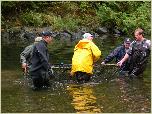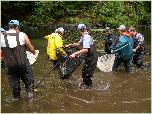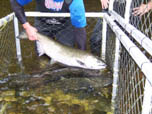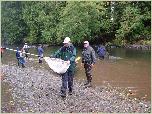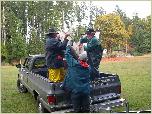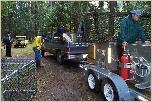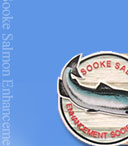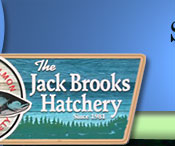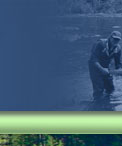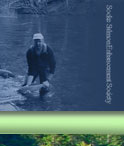Every year as Thanksgiving approaches, the Sooke Salmon Enhancement Society (SSES) musters the membership and anyone else who is interested down at the Sooke River at a designated spot to capture Chinook Salmon brood stock for the Hatchery.
This event takes a considerable amount of planning and effort by the organizers to be a success. Timing is crucial to this fishery which is carried out by seining Chinook in a select pool of the Sooke River. A big rain at the wrong time will send the fish up river to a very difficult location for capturing them. But it seems that no matter what the obstacle, SSES members make every outing a success just in partaking in the “Spirit of the Chinook Salmon.”
Hatchery Manager Bill Pedneault takes these matters very seriously when making the call to the membership to assemble at the side of the Sooke River. The response is great: everyone is there - kids and grandparents, fishermen and non-fishers, women and men. Nobody is excluded from the spectacle of the taking of brood stock. Tourists and hikers often join in the excitement.
Once the group is assembled, the Manager assigns tasks to work parties including divers, boat operators, net tenders, and data keepers. This task has been carried out for many years under his watchful eye as it was with his predecessors.
The net is spread out on the beach making sure that there are no tangles in the cork line (top line with floats) and lead line (weighted bottom line) or holes in the mesh.
The divers enter the water at the same time as the skiff operator tows the cork line of the net out into the upper side of the pool in the river. It is very important for the divers to be present as they aid in spooking the fish away from the lead line of the net and in getting the line over snags.
At the same, time another net is dragged across the tailout of the selected pool to ensure that the spooked Chinook do not escape the pool. The operation must be carried out as quickly as possible because the fish tend to scoot around the pool once spooked.
Once the upper net has spanned the pool, the seining team drags their net down river from either side to the tailout of the pool. When the two parties on either ends of the upper and lower nets meet, the cork line and lead line are closed. The lead line is brought ashore and the fish have no escape route. This is the most exciting part because once the lead line is closed and the cork line gets tightened up the volunteers see the result of their efforts. With a little luck and a lot of collective effort, large numbers of salmon are thrashing in the net, and the volunteers struggle to contain powerful bodies that can exceed sixty pounds!
Once the fish are captured, they are sorted through by species, releasing the Coho and Chum and holding Chinook in 10-foot holding tanks in the river.
When the tanker truck is filled to capacity, the fish are transported to the hatchery where they will be unloaded into one of six holding tanks.
During the unloading process, experienced volunteers determine if the fish are ripe for spawning or if they need to be held for a while to ripen. Being ripe for spawning is determined by rubbing a firm hand on the belly of the fish and pressing down toward the anal fin. The fish will be determined ripe if eggs come out of the female or if milt (sperm) comes out of the male. Ripe fish are put aside for immediate egg and milt collection.
After all fish have been unloaded, ripe females will be stunned and slit open to remove their eggs. The mass of eggs is weighted and a fifty gram sample is taken and counted in order to determine the total egg yield for that female.
The number of eggs per female is recorded, and then two male specimen are chosen as sperm donors. Occasionally Jacks (young males) are included as donors. This replicates as closely as possible the selection that occurs in natural spawning. The milt is blended with the eggs to fertilize them, and the process at the hatchery continues as the eggs are distributed into trays and placed in the incubator room.
After a period of time, the eggs begin to grow eyes. When they reach this stage, the eggs are put through a process called “shocking”. They are dropped from a prescribed height into cold water, which breaks the yolk in infertile eggs and makes them distinct from viable, fertilized eggs. They are “picked” by the members and the viable eggs are returned to the trays to continue growth.
During this stage, the eggs are carefully monitored and any further “mooners” or infertile eggs are removed to prevent the spread of fungus growth among the healthy population. As a dead egg decomposes, it can cause the death of any eggs in the vicinity, eventually destroying an entire tray of eggs.
The next stage is the “hatch”, when the eggs become “alevins”, a tiny fish with its yolk sac attached to its belly. They live off this yolk for a period of time until it is absorbed. This is called “buttoning up” and they are now ready for the next stage of their growth. The “fry”, as they are now called, are moved to the various troughs and tanks for rearing. This entails a daily routine of trough cleaning and fry feeding, seven days a week, for eight hours each day.
After several months of this TLC, the fry have grown into healthy young fish and are ready for release into the Sooke River, to continue their journey out to sea, and eventual return to the river, to perpetuate the cycle of the salmon.
